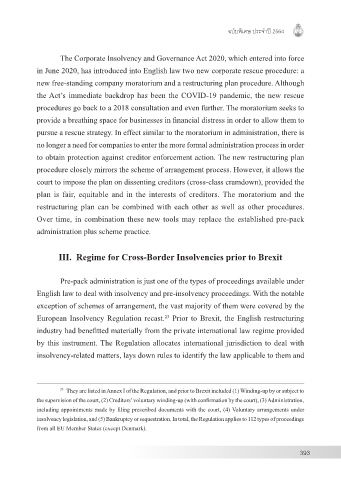Page 395 - วารสารกฎหมาย ศาลอุทธรณ์คดีชํานัญพิเศษ
P. 395
ฉบับพิเศษ ประจำ�ปี 2564
The Corporate Insolvency and Governance Act 2020, which entered into force
in June 2020, has introduced into English law two new corporate rescue procedure: a
new free-standing company moratorium and a restructuring plan procedure. Although
the Act’s immediate backdrop has been the COVID-19 pandemic, the new rescue
procedures go back to a 2018 consultation and even further. The moratorium seeks to
provide a breathing space for businesses in financial distress in order to allow them to
pursue a rescue strategy. In effect similar to the moratorium in administration, there is
no longer a need for companies to enter the more formal administration process in order
to obtain protection against creditor enforcement action. The new restructuring plan
procedure closely mirrors the scheme of arrangement process. However, it allows the
court to impose the plan on dissenting creditors (cross-class cramdown), provided the
plan is fair, equitable and in the interests of creditors. The moratorium and the
restructuring plan can be combined with each other as well as other procedures.
Over time, in combination these new tools may replace the established pre-pack
administration plus scheme practice.
III. Regime for Cross-Border Insolvencies prior to Brexit
Pre-pack administration is just one of the types of proceedings available under
English law to deal with insolvency and pre-insolvency proceedings. With the notable
exception of schemes of arrangement, the vast majority of them were covered by the
European Insolvency Regulation recast. Prior to Brexit, the English restructuring
23
industry had benefitted materially from the private international law regime provided
by this instrument. The Regulation allocates international jurisdiction to deal with
insolvency-related matters, lays down rules to identify the law applicable to them and
23 They are listed in Annex I of the Regulation, and prior to Brexit included (1) Winding-up by or subject to
the supervision of the court, (2) Creditors’ voluntary winding-up (with confirmation by the court), (3) Administration,
including appointments made by filing prescribed documents with the court, (4) Voluntary arrangements under
insolvency legislation, and (5) Bankruptcy or sequestration. In total, the Regulation applies to 112 types of proceedings
from all EU Member States (except Denmark).
393

